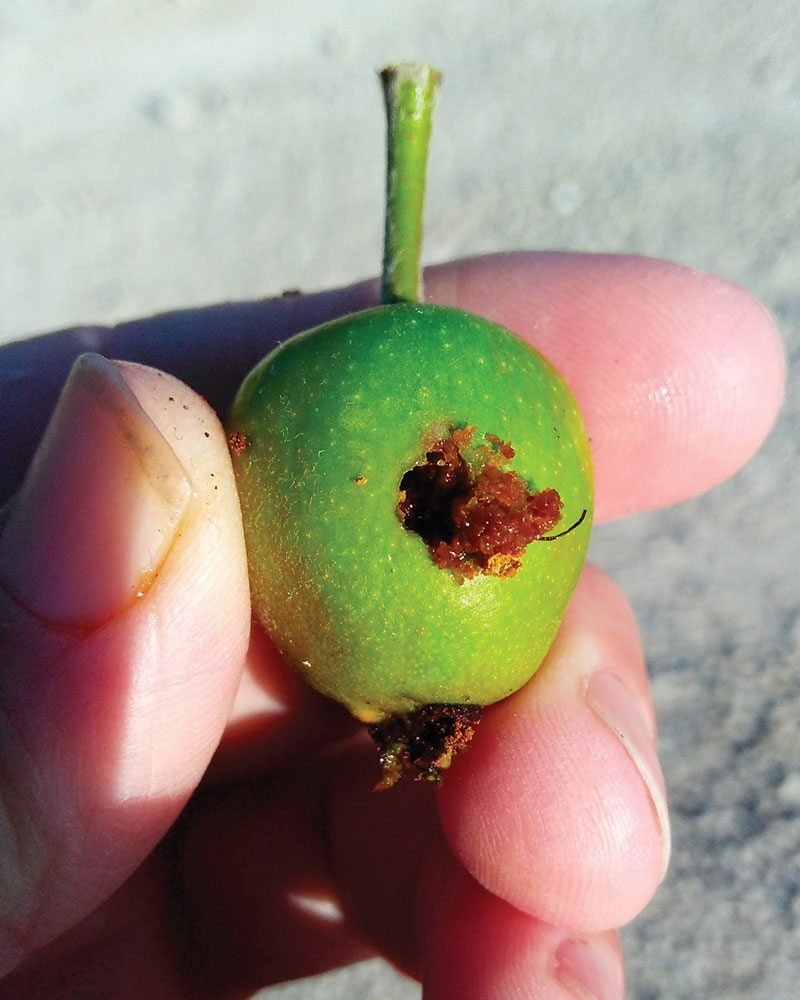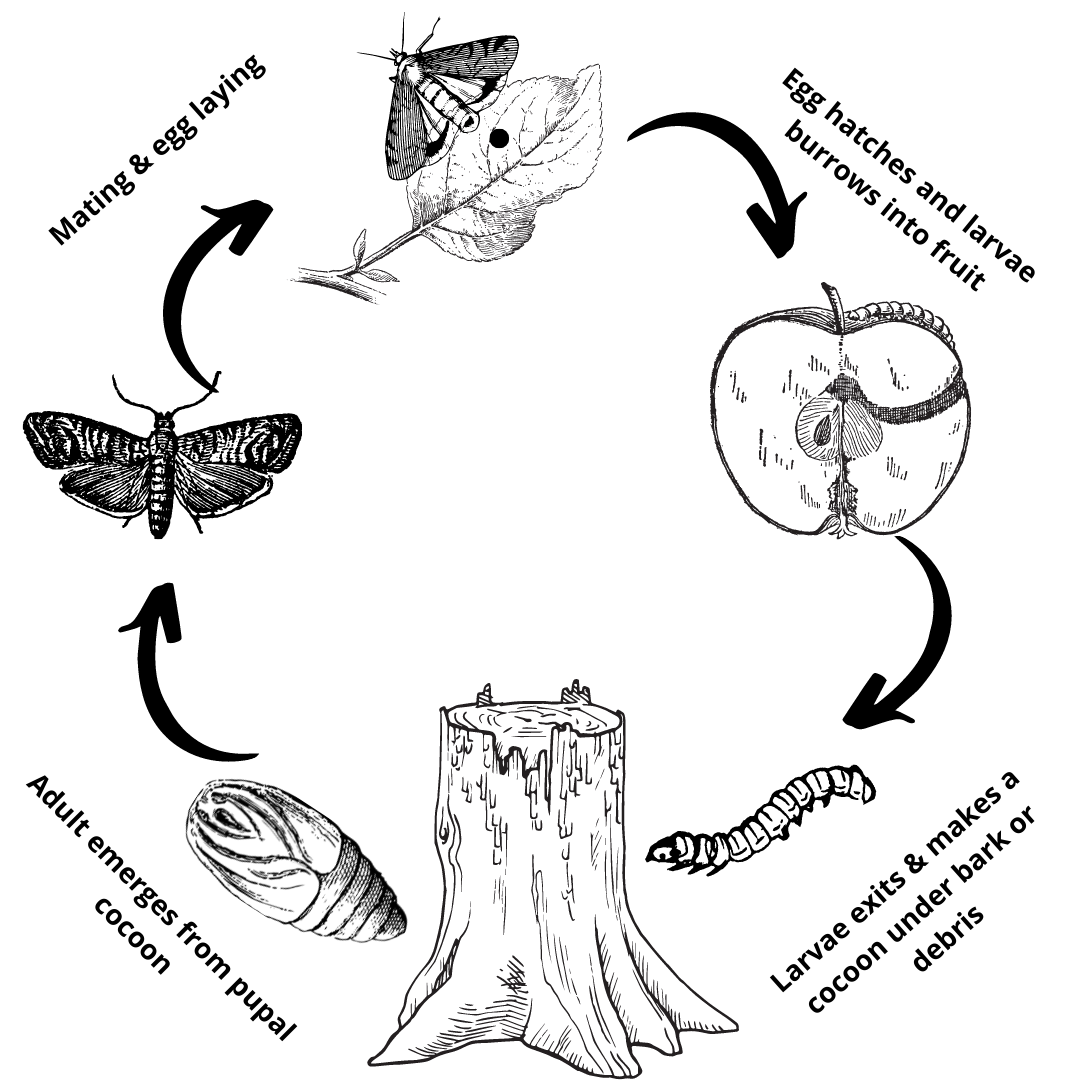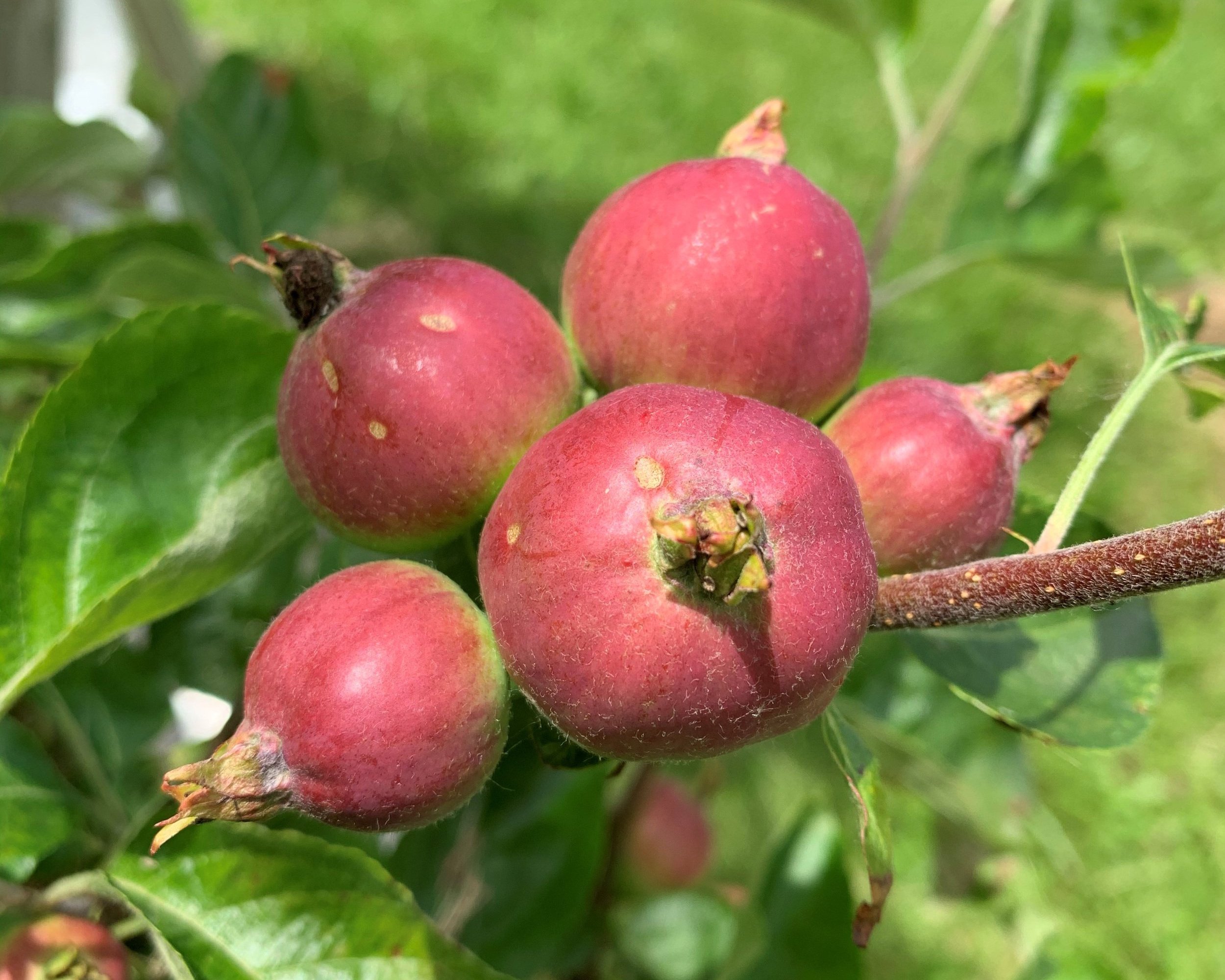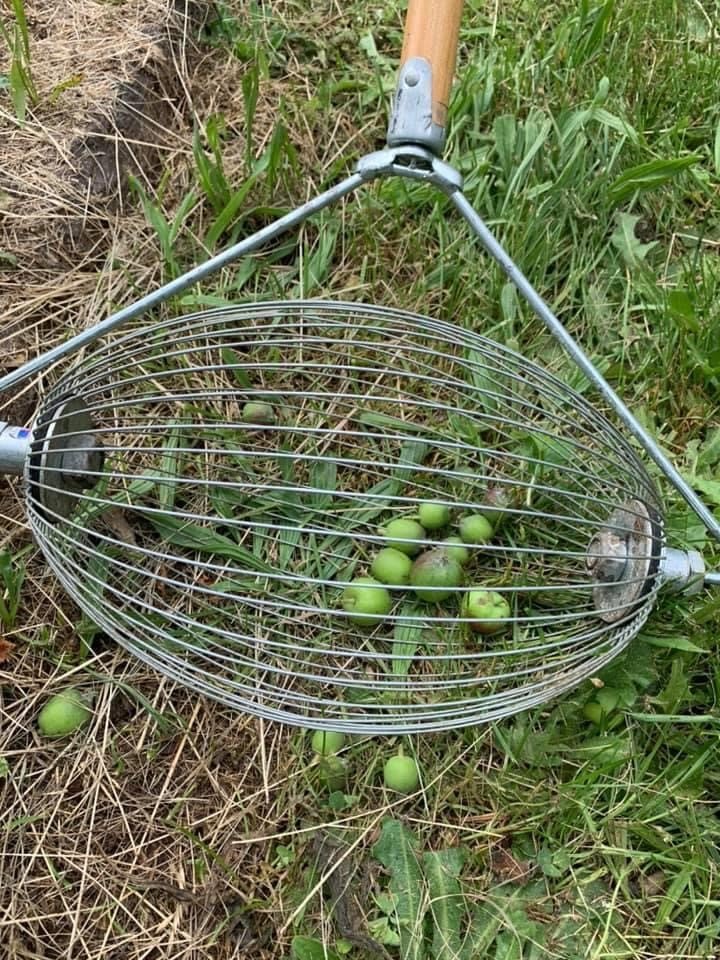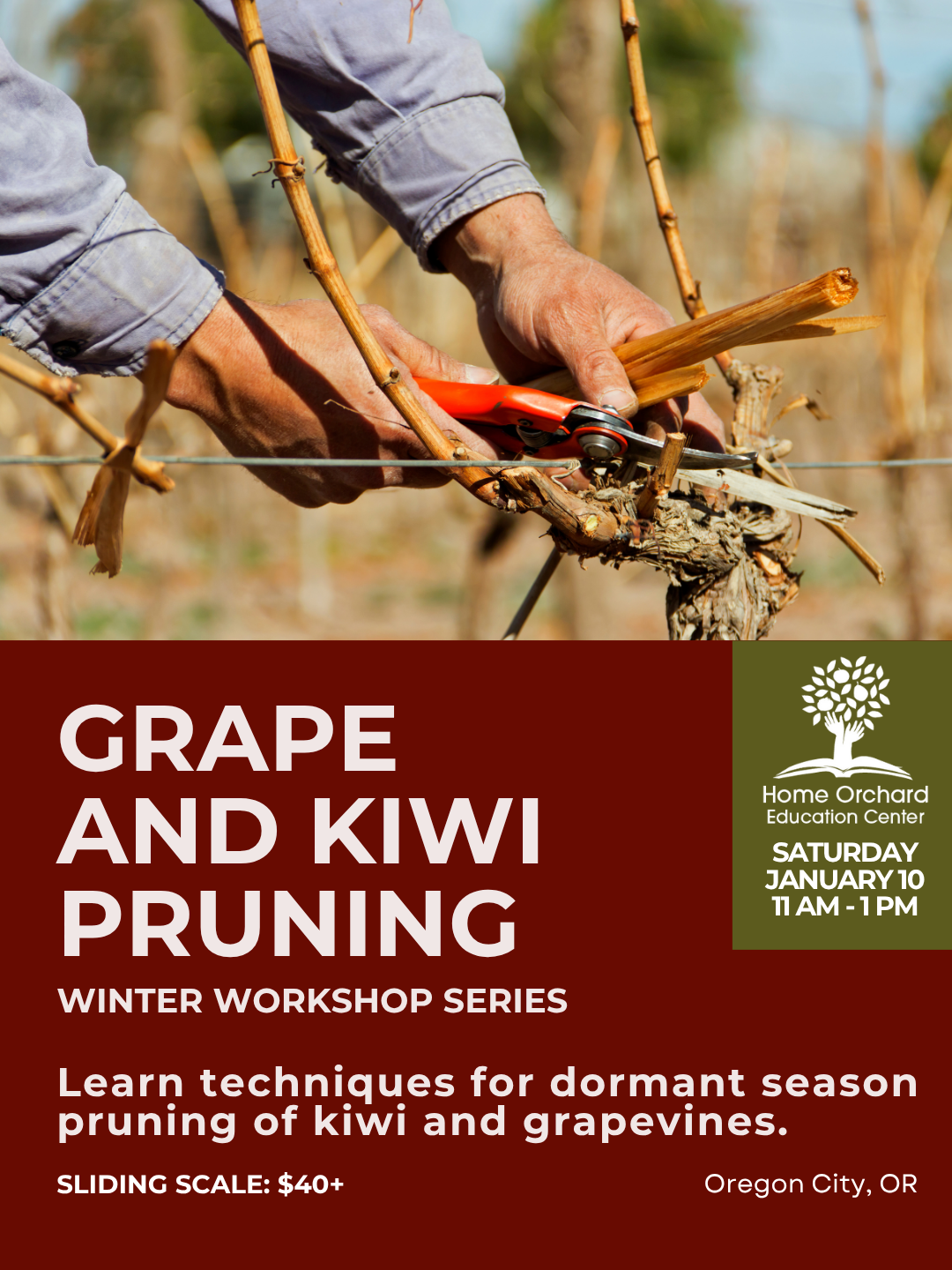Organic Codling Moth Control
One of the most troublesome of all apple & pear pests an organic orchardist might expect to encounter is the CODLING MOTH aka Cydia pomonella. If you only learn about one orchard pest this year, let it be this one.
Obvious codling moth damage. Note the telltale “frass” coming out of the hole.
Here in the HOEC Community Orchard, concerned home growers visit us all throughout the growing season, infested fruit in hand, asking - what are these worms in all of my apples!?
Usually when someone says “worm”, chances are high the offender is actually Codling Moth.
Adult Moths will appear in early spring right when your apple trees are blooming, but you may not have noticed these flying foes because they are generally active only at dusk. To understand how we can help reduce their population, we need to understand their life cycle.
LIFE CYCLE OF CODLING MOTH: Egg - Larvae - Pupae - Adult
ADULTS: These moths have one thing in mind; laying eggs on the leaves & developing fruits of your precious trees. Their eggs hatch within 6 to 20 days and turn into tiny larvae.
LARVAE: These little larvae (this is what everyone calls a worm) then bore into your developing fruits and tunnel their way to the core where they feed on apple seeds and flesh. After a few weeks when the larvae are finished chowing down, it tunnels back out to begin formation of a cocoon and become a pupa. On its way in and out, it will push out a bit of mush called “frass”. This is how you will be able to tell the fruit has been visited by codling moth larvae.
PUPAE: Codling Moth are exceptionally skilled when it comes to concealing themselves and cocoons into hidden nooks and crannies in loose bark as well as inside of fruit and it is near impossible to find them all after they have reached this point. Once the cocoon is made, the pupa may either overwinter inside of it, or emerge as an additional flush of adult moths in 2 to 3 weeks. Rinse & Repeat!
METHODS OF ORGANIC CONTROL:
How can a home orcahrdist prevent damage inflicted by these little buggers in an organic setting?
SELECT FOR SUCCESS
Unfortunately there are no specific varieties of apples or pears that are completely resistant to codling moth, although there are a few selection criteria that might help.
Varieties with firmer skin and flesh have been noted as somewhat less susceptible.
Early maturing varieties are less prone to damage from a second or third flush of pests; thus requiring less monitoring and care.
Select a dwarfing or semi-dwarfing rootstock so that your tree can be maintained to a height that is within your reach. If it’s too tall, you’re less likely to be able to be able to use the following methods of control.
THIN YOUR FRUITLETS
Make sure to thin your fruitlets and in the process, remove any infected fruit from your trees. A common point of larvae entry is where two fruits are touching. Among many other benefits, thinning fruitlets results in reduced pest damage as well as making good spray coverage possible. You can learn how to thin fruitlets in another one of our blog posts, by clicking here.
KEEP IT WITHIN REACH
Keep the canopy pruned to a more manageable height that is easy to reach for hand control and pest removal as well as easier coverage when spraying natural preventatives. Choosing a dwarfing or semi-dwarfing rootstock will make this more realistic.
A cluster of apple fruitlets. Thinning involves removing all but one or two.
A volunteer in the HOEC Orcchard ruthlessly thinning fruitlets.
Volunteers can harvest and care for this tree on dwarfing rootstock from the ground.
BAGGING
Bagging is an extremely effective although unrealistically time consuming technique that can be used to protect fruit from codling moth. With this technique, individual fruits (clusters thinned to one fruit) are enclosed in lunch sized paper bags approximately six weeks after bloom. Not all varieties lend themselves to this method, and it is often not possible to bag short stemmed apples such as Gravenstein.
TRUNK BANDING
For those who have only a handful of trees (or a large volunteer team!), a piece of corrugated cardboard, wrapped around each tree trunk near the base, functions as a trap for mature codling moth larvae as they search for a concealed place to pupate. Trunk banding is most effective on trees with smoother bark, so the makeshift traps are not out-shined by better natural hiding places in rough deep crevices. Make sure to check and remove and replace the band once or twice during the growing season and destroy any larvae or cocoons.
We use this “nut roller” to pick up fallen fruitlets. It’s fast, easy, and you can usually find a kiddo who will volunteer to help!
SANITATION
Again and again we will tell you that one of the most important things any orchardist can do for the health of their fruit is focus on orchard sanitation. Orchard sanitation refers to the removal of infested fruit and debris from both the tree as well as the grounds on a regular basis.
Check your fruit regularly for frass-filled holes and destroy any that you find infested. At this point the larvae have already invaded your fruit, but you can still help prevent a second cycle and this will also reduce pressure the following season. The most critical time to do this in our area is MAY & JUNE although you should continue to monitor and remove throughout the year.
Pick up any fallen fruit or pruning from the orchard floor. While we are all for the incorporation of a rich variety of mulching materials in any healthy garden, leaving pest or disease infested fruit litter on your orchard floor only aids in the creation of a perfect environment for overwintering pests.
Do not move infested fruits to another area of the orchard unless you keep a very hot compost or very hungry chickens. You will want to grind, burn, or remove the infected fruit and debris from your property.
Enlist The Help Of Beneficial Critters!
Woodpeckers: The work of woodpeckers who are specifically useful for insect control has been recognized and studied by entomologists for quite some time, as many woodpeckers are especially efficient when it comes to seeking out and destroying damaging pests that can wreak havoc on your orchard fruits. They have even been observed locating and removing moth larvae from inside of fruit without causing additional damage! To learn more about woodpeckers in the home orchard, click here to read our blog post.
Consider Poultry:
Letting poultry such as chickens or guinea fowl free range in the orchard when reasonable, can go a long way towards the reduction of overwintering pest populations of all kinds. Not only do poultry eat up fallen and potentially infected fruits, but they are also exceptionally skilled when it comes to hunting for bugs and hidden larvae.
Trichogramma Wasps: Minute parasitic wasps are available from several suppliers of biological control organisms and have potential to help suppress codling moth populations. Although studies are limited and this should still be considered experimental it’s worth a try!
Additional Tiny Predators: Assassin bugs & green lacewing larvae can provide some supplemental control of codling moth, and other insects & mites that could damage your crop.
Kaolin Clay
Kaolin clay (i.e. Surround) is an effective organic approved material available to home orchardists, that can be sprayed onto fruit and foliage. When properly applied, acts as a barrier to prevent egg laying and penetration of fruits. It has the added benefits of preventing sunburn and deterring additional pests. The clay does however leave a white residue that will need to be washed off.
Trapping
There are a number of different types of traps used to monitor and trap Codling Moths. Order one online, or make your own. One easy way to attract moths of many different varieties is by use of a DIY fermenting sugar-based lure placed in a gallon jug with a 2 inch hole cut just below its shoulder. Below we share three common DIY recipes and traps you can make yourself with just a few ingredients and simple supplies. Try them all and let us know what worked the best for you!
HOMEMADE LURE RECIPES:
Instructions:
Mix in a one-gallon container.
Let the mixture sit and after 24 hours it is ready for use.
Add enough water to fill the gallon

